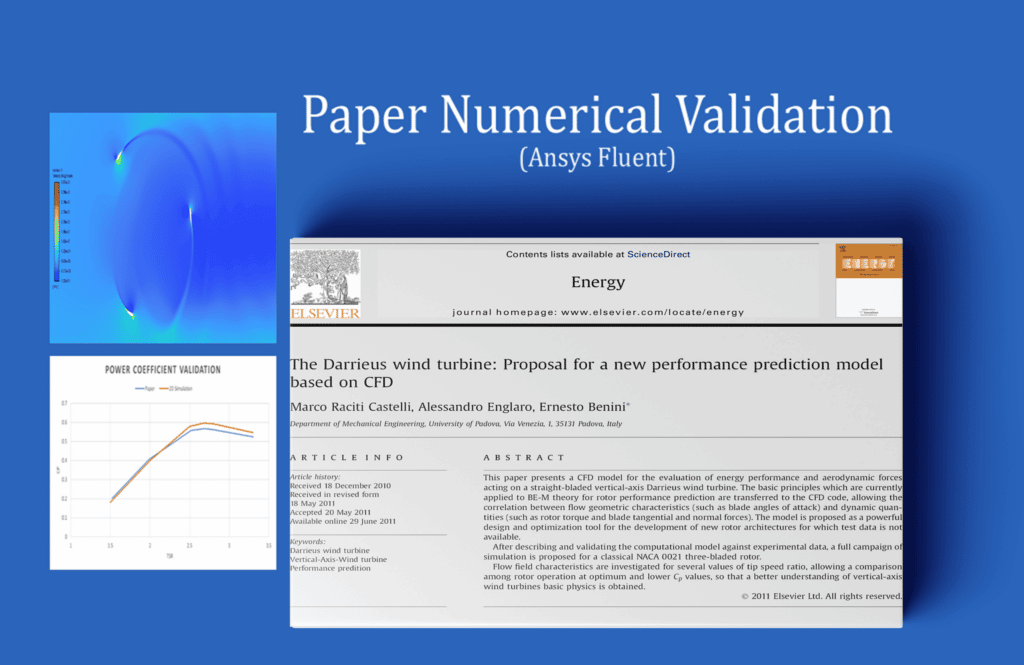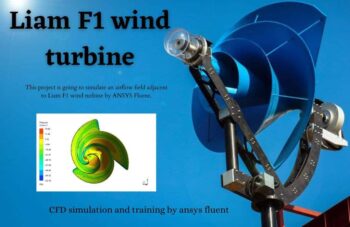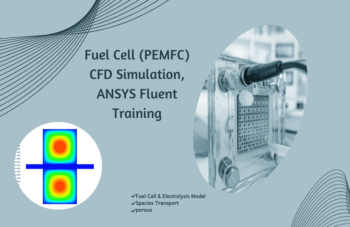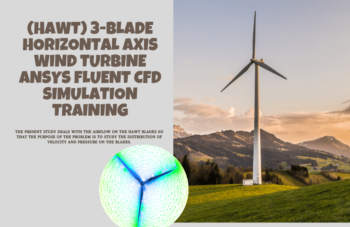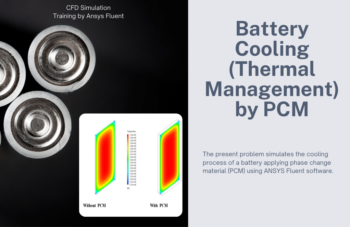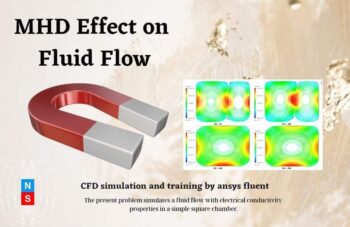Project Outsourcing
Outsource your project to the MR CFD simulation engineering team. Our experts are ready to carry out every CFD project in all related engineering fields. Our services include industrial and academic purposes, considering the ANSYS Fluent software's wide range of CFD simulations. By outsourcing your project, you can benefit from MR CFD's primary services, including Consultation, Training, and CFD Simulation. The project freelancing procedure is as follows:
An official contract will be set based on your project description and details.
As we start your project, you will have access to our Portal to track its progress.
You will receive the project's resource files after you confirm the final report.
Finally, you will receive a comprehensive training video and technical support.
What is Electrical and Power Engineering?
Electrical and Power Engineering is a discipline of engineering that deals with the study and application of electricity, electronics, and electromagnetic. It covers a wide variety of subjects, including as power production, transmission, distribution, and usage, as well as electrical system and component design. Electrical and Power Engineering is also concerned with the investigation of electrical machines, power electronics, and control systems.
Electrical and Power Engineering is the discipline of engineering dealing with the practical uses of electricity in all of its forms, including electronics. Electronics engineering is a branch of electrical engineering concerned with using the electromagnetic spectrum and applying electronic devices such as integrated circuits and transistors. To accomplish specified functionality, electronic engineers develop and test circuits that leverage electrical components’ electromagnetic characteristics, including resistors, capacitors, inductors, diodes, and transistors.
Thermal management of electrical systems has been an essential topic of concentration in electronics research and development as electronic devices get smaller daily. Failure to provide adequate heat dissipation (cooling) in an electronic device, such as a computer or a smartphone, can result in a temporary or even permanent breakdown of the device due to the occurrence of extremely high temperatures in various parts, such as printed circuit boards (PCBs), central processing units (CPUs), or disk drives, which causes these components to malfunction. Thermal management must be given top importance in engineers’ electrical equipment design.
How CFD simulation can be applied in Electrical and Power Industries?
CFD simulation may be used to study the performance of electrical components such as transformers, motors, and generators in the electrical and power sectors. CFD may be used to examine the flow of air around the components, assisting in the identification of locations of high heat generation and low efficiency. CFD may also be used to study the performance of electrical systems, such as power grids, and to increase the efficiency of electrical component design. CFD may also be used to examine the performance of cooling systems, such as fans and radiators, to ensure that they are running at ideal temperatures.

- mixed convection effects (forced convection plus effects of natural convection)
- buoyancy due to natural convection
- conduction and heat dissipation within PCBs
- boundary layer airflow and conjugate heat transfer on arbitrarily complex geometries and shapes
- thermal radiation between all components and to the external environment.
MR CFD services in the Electrical and Power Engineering and Industries
Electrical and power engineering CFD services may be used to simulate and study the performance of electrical and power systems. CFD may be used to examine the flow of electricity through a system, component thermal performance, and the influence of external conditions on the system. CFD may also be used to optimize the design of electrical and power systems as well as to detect possible problems before they develop. CFD may also be used to mimic the behavior of electrical and power systems under various operating situations, such as when there is a power loss or a surge in demand.
This article covered a small number of CFD applications in improving Electrical and Power Engineering. The Power industry is full of applications for CFD, From battery cooling using PCM materials and Thermal Management of Battery (Using Nano Fluid) to the simulation of the Electric Field Effect on Nanofluid Heat Transfer, Considering Charge Density (EHD) and Magnetic Field Effect on Nanofluid Heat Transfer (MHD).
Fluid dynamics are fundamental to most facets of the Electrical sector. Although real prototypes are standard for later stages of development, design, and optimization during earlier stages can be significantly accelerated with CFD studies. With several years of experience simulating various problems in various CFD fields using ANSYS Fluent software, we are ready to offer extensive services of Simulation, Consultation, and Training services.
MR CFD services in the Electrical and Power engineering field can include a variety of services such as:
Transformer cooling
The present project uses ANSYS Fluent software to simulate the air conditioning within a Transformer Room. This CFD project is carried out and investigated using CFD analysis.
Transformers are devices that use electromagnetic induction to transmit electrical energy between two or more windings. Due to safety concerns, these transformers are housed in a room, where an adequate air conditioning system should be installed.
CFD on Increasing the Power of Vertical-Axis and Horizontal-Axis, Wind and Water Turbines
The power of vertical-axis and horizontal-axis wind and water turbines may be increased using CFD simulation. CFD simulation may be used to study air or water flow around turbine blades and improve blade design to maximize power production. CFD simulation may also be used to study the effects of turbulence on turbine blades and optimize blade design to decrease turbulence effects. CFD simulation may also be used to study the effects of wind shear on turbine blades and optimize blade design to decrease wind shear impacts.
CFD modeling may also be used to investigate the effects of blade pitch on turbine blades and improve blade design to optimize power production. CFD modeling may also be used to investigate the impact of blade form on turbine blades and improve blade design to maximize power production.
Water Turbine Training Package
This training package includes ten distinct CFD simulation tasks for various types of water turbines using ANSYS Fluent software (Horizontal Axis & Vertical Axis). This program is recommended by MR-CFD for people interested in Electrical and Power Engineering, particularly turbine analysis. This software teaches you to several water turbine designs and how to simulate them numerically, taking into account a wide range of related studies.
Begin the training package with two papers that validate the performance of a lift-based in-pipe water turbine using the mesh motion approach and the performance of a horizontal axis tidal current turbine by blade design using CFD simulation.
Following the validation of our Computational Fluid Dynamics methodology, we investigate various types of famous water turbines (Darrieus, Pelton Wheel, Archimedes Screw Turbine (AST), Water Wheel, Kaplan, Francis Turbine,…) using various CFD methods (Moving Mesh, Frame Motion (MRF), Fluid Solid Interaction (FSI), Dynamic Mesh, Cavitation, Multiphase VOF model) and turbine configurations.
Vertical Axis Wind Turbine Training Package
This training bundle comprises eight distinct CFD simulation tasks for Vertical Axis Wind Turbines using ANSYS Fluent software (VAWT). This software is recommended by MR-CFD for people interested in renewable energy engineering, particularly turbine analysis. This software teaches you to several turbine designs and how to simulate them numerically, taking into account a wide range of relevant studies.
Begin with a paper validation of Vertical Axis Wind Turbines (VAWT) using CFD simulation using ANSYS Fluent software. We compare the flat and serrated airfoils to examine the different architectures of Darrieus turbine performance after confirming our Computational Fluid Dynamics approach. After that, we will model additional types of VAWTs such as H-Type and other designs of Helical and Savinius turbines.
 Horizontal Axis Wind Turbine Training Package
Horizontal Axis Wind Turbine Training Package
This training bundle comprises eight distinct CFD simulation tasks for Horizontal Axis Wind Turbines utilizing ANSYS Fluent software (HAWT). This program is recommended by MR-CFD for people interested in renewable energy engineering, particularly wind turbine analysis. This software teaches you to several turbine designs and how to simulate them numerically, taking into account a wide range of relevant studies.
Begin with two simple 3-blade Horizontal Axis Wind Turbines (HAWT) with varied structures to familiarize yourself with these types of turbines. Then we look at the turbine base effect and look at wind farms. After that, we will simulate the duct effect on HAWT performance and investigate more complex HAWT models, such as the Liam F-1 wind turbine. Lastly, it is time to examine the sound creation with HAWT considering two different acoustic models, including Broadband and F-WH.
CFD to Enhance IGBT Cooling
ANSYS Fluent software is used to model the cooling of an IGBT heat sink in this project. This CFD project is carried out and investigated using CFD analysis. A three-terminal power semiconductor device known as an insulated-gate bipolar transistor (IGBT) is primarily employed as an electronic switch. An IGBT creates a lot of heat and can be damaged by too much heat.
This surplus heat may be evacuated using air cooling or liquid cooling techniques, such as heat sinks, leading to enhanced performance and enabling considerably greater power densities and more compact modules. The IGBT is a solid-state switch that works by applying a voltage to a portion of a semiconductor to establish an electrical circuit. The IGBT is unusual because it eliminates the thyristor function, resulting in a more efficient device. Modern solar and wind turbine inverters, motor drives, and power systems use IGBTs.
Thermal control of IGBTs is a critical component of a well-designed power electronics system. Depending on its use case, switching state, and power input, IGBT modules can vary in temperature and create much heat. Even though IGBTs have aided us in making significant progress with renewable energy, inefficiencies related to heat loss and operating temperatures remain a design restriction.
CFD has achieved enormous popularity in modeling cooling efficacy within racks and aisles. Therefore it appears sensible to utilize it as a robust and dynamic tool to model data center settings. It performs a three-dimensional examination of hot and cold air circulation within the cold plate, identifying hot spots or regions that require further cooling or overly chilly parts. The customer may forecast the cooling power needed for his application using CFD.
 Enhancement of Mining Farms Using CFD
Enhancement of Mining Farms Using CFD
In this project, ANSYS Fluent software is used to model server room cooling, which includes 6 cabinets. This CFD project is carried out and investigated using CFD analysis.
Accurate environmental control, airflow planning, fire suppression systems, cable management solutions, redundant power sources, and physical security are all critical aspects of server room design. Crypto farmers don’t have the budget, the margins, or the time to take the traditional route. They typically use whatever space is available a room in a house, a small office space, or an unused basement. Others utilize large warehouses where the hot air can dissipate quickly. However, most of these spaces soon face challenges concerning overheating, rising electricity costs, and low efficiency.
The best way to solve these issues is through CFD simulation. It is possible to simulate room conditions to optimize the position of servers and determine how best to set up the airflow. As every crypto farm is unique, this has to be done individually. A simple simulation can rapidly determine the optimum amount of computing density for specific square footage. It calculates the facility’s temperature, air velocity, and hot and cold air interchange. A heat map highlights equipment hot spots that are likely to result in a server meltdown. This is accompanied by recommendations on modifying the room configuration to optimize crypto mining efficiency, performance, and cost.
Electrical and Power Engineering MR CFD Projects
MR CFD is ready to offer extensive modeling, meshing, and simulation services. Following is a brief list of the CFD simulation projects for Electrical and Power Engineering by MR CFD:
CFD on Increasing the Hydropower of Vertical-Axis Turbines in Waterline
This paper “Numerical analysis of lift-based in-pipe turbine for predicting hydropower harnessing the potential in selected water distribution networks for waterlines optimization” models and simulates the possibility of operating a power plant inside a pipe using a spherical turbine based on lift-based in-pipe. NACA airfoils are used to create turbine hydrofoil profiles. The CAD of a spherical lift turbine based on peak and bottom volume discharge rates was simulated and studied in ANSYS Fluent software for this purpose. The power output time series is computed from the discharge change time series.
Saving water and energy has been one of the world’s top priorities in recent years, and it is only going to become worse. Several technical solutions have been offered in this area, such as replacing pressure relief valves with power generators to create electricity while properly regulating the pressure of water distribution networks. The hydraulic energy efficiency of water, which may be transformed directly into electricity, is used to boost the energy efficiency of water delivery systems. Such a procedure employs a clean energy source, which is sometimes overlooked in water resources and minimizes energy reliance on the power grid as well as system running expenses.
Horizontal Axis Tidal Turbine
The current project uses ANSYS Fluent software to model a horizontal-axis water turbine. The CFD simulation results are compared and confirmed using the paper “Performance of horizontal axis tidal current turbine by blade configuration”.The water flows at a velocity of one meter per second and passes through the water turbine; hence, by colliding the water flow to the turbine blades and establishing a torque force on the blades, a rotating motion is created in the turbine blades, causing a rotational flow in the surrounding water. The current model is built in three dimensions, thus the portions relating to the turbine blades have the shape of an airfoil of type S814.
Wind Turbine Blade Simulation in Wind Farms
In this project, CFD is used to simulate the flow of air around a wind turbine blade and examine the turbine’s performance. The current challenge uses ANSYS Fluent software to model wind turbines in a series configuration in a wind farm. This CFD project is carried out and investigated using CFD analysis. The wind turbines investigated in this study are horizontal axis wind turbines (HAWT), which implies that the ambient wind flow is horizontally parallel to the turbine’s axis.
Fuel Cell Simulation
There are 2 major types of fuel cells. The first is PEMFC (Proton Exchange Membrane Fuel Cell or Polymer Electrolyte Membrane Fuel Cell), and the second one is SOFC (Solid Oxide Fuel Cell).
Battery Simulation
There are two major CFD methods to simulate batteries, MSMD (Multi-Scale Multi physics Battery)and NTGK (Newman, Tiedemann, Gu, and Kim).
Air Cooled Steam Condensor (ACSC) Performance with Diffuser Orifice Plate
Based on the paper “Impact of a diffuser orifice plate on the performance of an air-cooled steam condenser,” this project mimics the ACSC system in a 600 MW power plant. The current numerical CFD simulation work’s findings are compared and validated with the reference article using ANSYS Fluent software.
The primary goal of developing and implementing these systems in power plants is to reduce energy waste. These systems condense hot steam from the turbine and move water from the distillation process to the pump section of the steam turbine. The power plant under consideration in this paper has seven rows of ACSC systems. This CFD simulation focuses on the fourth row.
Electrical device cooling
This training package comprises ten distinct CFD simulation tasks for Electronics Cooling using ANSYS Fluent software. This program is recommended by MR-CFD for people interested in Electrical & Power engineering, particularly eclectic device cooling. This package will teach you about various electric device designs and how to simulate cooling for them numerically, taking into account a wide range of relevant research.
Begin with a paper validation of cooling of a serrated finned tube using CFD simulation using ANSYS Fluent software. We analyze the cooling state of a server room with six cabinets after validating our Computational Fluid Dynamics approach. Next, using nano-fluid and PCM, we will mimic battery cooling and thermal management. The cooling of several heat sinks (IGBT, Pin and Plate, Porous) is then simulated. Lastly, we will conclude this training package with two more instances of microchannels. You may claim to be an expert in modeling and evaluating any CFD simulation related to electronics cooling after studying this wonderful and practical training package. Afterward, you’ll be prepared to work as a CFD engineer in the associated sectors.
Magnetic Force Effect on an Airfoil CFD Simulation
The present project uses ANSYS Fluent software to model the Magnetic Force Effect on a NACA 0015 airfoil. This CFD project is carried out and investigated using CFD analysis. This airfoil is symmetrical and produces no lift force at zero attack angle. The lift coefficient of this airfoil is investigated at various attack angles with and without Magnetic Hydro-Dynamics (MHD). We investigate the separation and the greatest angle of attack where the separation does not exist in this situation. Separation occurs at a greater angle of attack when magnetic force (MHD) is applied.
 Darrieus Turbine CFD Simulation (Performance Prediction)
Darrieus Turbine CFD Simulation (Performance Prediction)
A vertical-axis wind turbine (VAWT) is a form of the wind turbine in which the primary rotor shaft is perpendicular to the ground and transverse to the wind. This configuration allows VAWTs to catch wind energy at all azimuth angles. VAWTs are classified into three types: drag-based Savonius wind turbines, lift-based Darrieus wind turbines, and H-type wind turbines.
The H-type wind turbine is similar to the Darrieus but has different blades. We hope to validate a related study titled “The Darrieus wind turbine: Proposal for a novel performance prediction model based on CFD” in this project. The turbine has three NACA0021 blades with a diameter of 1010mm, as illustrated in the picture below from the paper’s 2D simulation.
FSI Method for Water Turbine
The current study explores the water flow around a vertical water turbine using ANSYS Fluent software’s unsteady CFD simulation. In this scenario, it is considered that the flow of the passing fluid affects the turbine blades; that is, the fluid flowing through the turbine blades impedes forces on the turbine body, and these forces produce deformation or resizing of the body of these blades. As a result of the current problem including two fluid and solid solutions at the same time, the FSI approach and the coupling between the fluid flow and the Transient Structural are employed.
Electrical and Power Industrial Companies

- ABB Group
- Siemens
- General Electric
- Schneider Electric
- Eaton Corporation
- Toshiba
- Mitsubishi Electric
- Hitachi
- Alstom
- Areva
MR CFD Industrial Experience in the Electrical and Power Field
Following are two examples of Electrical and Power industrial projects that are recently simulated and analyzed by MR CFD in cooperation with related companies.
Simulation of a Generator Room Ventilation:
In this project, CFD is used to model the flow of air around a generator and examine its performance. In this study, the ventilation of an industrial generator room was simulated and the effects were studied.
The heating, ventilation, and air conditioning (HVAC) of a generator room are modeled in this study using Ansys Fluent software. Following the completion of the simulations in which a generator room is originally simulated without a fan, it is discovered that the room temperature with 32 generators is quite high. The usage of 32 fans with 11,000 CFM reduces the temperature significantly. Nevertheless, 32 fans with 36,500 CFM have been installed to increase ventilation and temperature and provide the needed thermal comfort between generator rows.
Generators are one of the most common and important sources of electricity in a variety of sectors. Generators emit a lot of heat, which might interfere with thermal comfort if there are a lot of them. As a result of the severe heat in the summer, operators are unable to approach the generators. Hence, to tackle this issue, we employed numerous fans to make the generator’s room temperature comfortable for the workers.
Pelton Wheel Turbine
This is an article on a well-known impact turbine. The Pelton turbine is the only impact hydraulic turbine in operation today. According to Newton’s second law, this turbine generates energy by using a fluid jet. This turbine is rotated by a pressure water nozzle struck tangentially to the bucket linked to the runner. The buckets are paired so that the momentum is transferred smoothly and effectively in addition to the balance of force exerted. The pellets come in various sizes. Because these turbines are specially constructed for huge heads, large ones are employed in dams, while tiny sizes are used to generate energy in distant places.
Pelton wheel turbines are a form of impulse turbine that converts high-pressure fluid energy into mechanical energy. They are often utilized to produce energy in hydroelectric power plants. The performance of a Pelton wheel turbine is numerically studied in this research. The research was carried out with the use of a commercial computational fluid dynamics (CFD) software program. The study’s findings were compared to experimental data from an industrial application. The results revealed a high level of agreement between the numerical and experimental data. The study also discovered that the nozzle angle, number of buckets, and flow rate all had an effect on turbine efficiency. The findings of this study can be utilized to improve the design of Pelton wheel turbines for industrial applications.
MR CFD conducted numerous outsourced CFD simulation projects for industrial companies and research in Electrical and Power Engineering applications. With several years of experience simulating various problems in various CFD fields using ANSYS Fluent software, the MR-CFD team is ready to offer extensive services of CFD Simulation, Training, and Consultation.
You may find the learning products in the Electrical and Power Engineering CFD simulation category in Training Shop. You can also benefit from Electrical and Power Engineering training packages appropriate for Beginner, Intermediate, and Advanced users of ANSYS Fluent. Also, MR CFD is presenting the most comprehensive Electrical and Power Engineering Training Course for all ANSYS Fluent users from Beginner to Experts.
Our services are not limited to the mentioned subjects, and the MR CFD is ready to undertake different and challenging projects in the Electrical and Power Engineering modeling field ordered by our customers. We even carry out CFD simulations for any abstract or concept design you have in your mind to turn them into reality and even help you reach the best design for what you may have imagined. You can benefit from MR CFD expert consultation for free and then outsource your Industrial and Academic CFD project to be simulated and trained.
By outsourcing your project to MR CFD as a CFD simulation consultant, you will not only receive the related project’s resource files (Geometry, Mesh, Case & Data, …), but also you will be provided with an extensive tutorial video demonstrating how you can create the geometry, mesh, and define the needed settings(pre-processing, processing, and post-processing) in the ANSYS Fluent software. Additionally, post-technical support is available to clarify issues and ambiguities.




